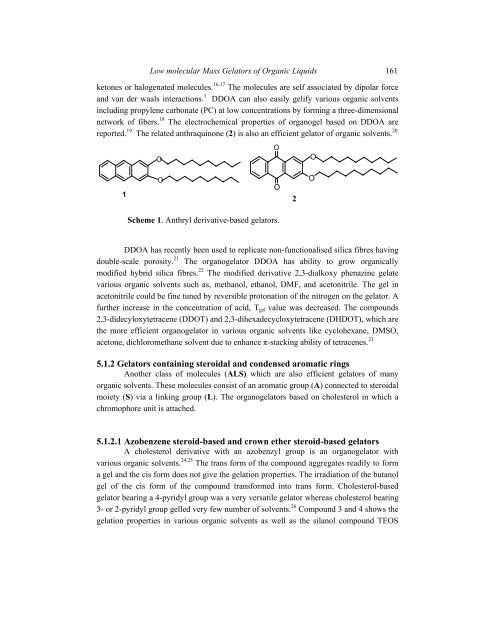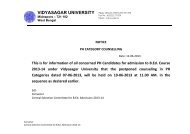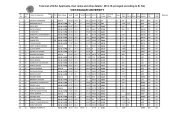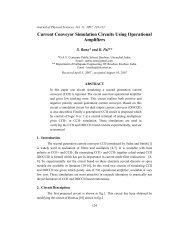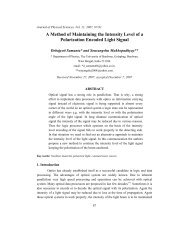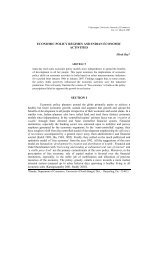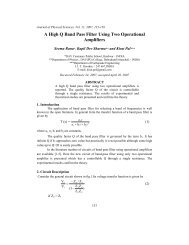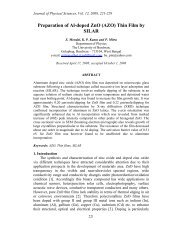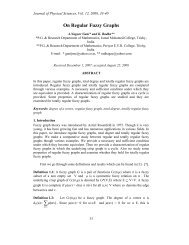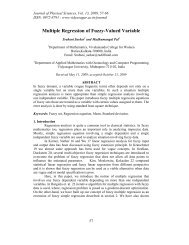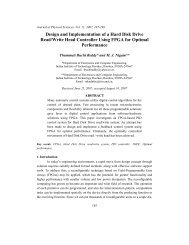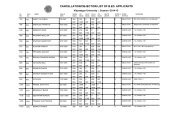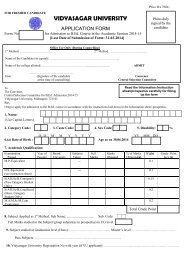Low Molecular Mass Gelators of Organic Liquids - Vidyasagar ...
Low Molecular Mass Gelators of Organic Liquids - Vidyasagar ...
Low Molecular Mass Gelators of Organic Liquids - Vidyasagar ...
You also want an ePaper? Increase the reach of your titles
YUMPU automatically turns print PDFs into web optimized ePapers that Google loves.
<strong>Low</strong> molecular <strong>Mass</strong> <strong>Gelators</strong> <strong>of</strong> <strong>Organic</strong> <strong>Liquids</strong> 161<br />
ketones or halogenated molecules. 16,17 The molecules are self associated by dipolar force<br />
and van der waals interactions. 1 DDOA can also easily gelify various organic solvents<br />
including propylene carbonate (PC) at low concentrations by forming a three-dimensional<br />
network <strong>of</strong> fibers. 18 The electrochemical properties <strong>of</strong> organogel based on DDOA are<br />
reported. 19 The related anthraquinone (2) is also an efficient gelator <strong>of</strong> organic solvents. 20<br />
O<br />
O<br />
O<br />
1<br />
O<br />
O<br />
1a 2<br />
O<br />
Scheme 1. Anthryl derivative-based gelators.<br />
DDOA has recently been used to replicate non-functionalised silica fibres having<br />
double-scale porosity. 21 The organogelator DDOA has ability to grow organically<br />
modified hybrid silica fibres. 22 The modified derivative 2,3-dialkoxy phenazine gelate<br />
various organic solvents such as, methanol, ethanol, DMF, and acetonitrile. The gel in<br />
acetonitrile could be fine tuned by reversible protonation <strong>of</strong> the nitrogen on the gelator. A<br />
further increase in the concentration <strong>of</strong> acid, T gel value was decreased. The compounds<br />
2,3-didecyloxytetracene (DDOT) and 2,3-dihexadecycloxytetracene (DHDOT), which are<br />
the more efficient organogelator in various organic solvents like cyclohexane, DMSO,<br />
acetone, dichloromethane solvent due to enhance π-stacking ability <strong>of</strong> tetracenes. 23<br />
5.1.2 <strong>Gelators</strong> containing steroidal and condensed aromatic rings<br />
Another class <strong>of</strong> molecules (ALS) which are also efficient gelators <strong>of</strong> many<br />
organic solvents. These molecules consist <strong>of</strong> an aromatic group (A) connected to steroidal<br />
moiety (S) via a linking group (L). The organogelators based on cholesterol in which a<br />
chromophore unit is attached.<br />
5.1.2.1 Azobenzene steroid-based and crown ether steroid-based gelators<br />
A cholesterol derivative with an azobenzyl group is an organogelator with<br />
various organic solvents. 24,25 The trans form <strong>of</strong> the compound aggregates readily to form<br />
a gel and the cis form does not give the gelation properties. The irradiation <strong>of</strong> the butanol<br />
gel <strong>of</strong> the cis form <strong>of</strong> the compound transformed into trans form. Cholesterol-based<br />
gelator bearing a 4-pyridyl group was a very versatile gelator whereas cholesterol bearing<br />
3- or 2-pyridyl group gelled very few number <strong>of</strong> solvents. 26 Compound 3 and 4 shows the<br />
gelation properties in various organic solvents as well as the silanol compound TEOS


